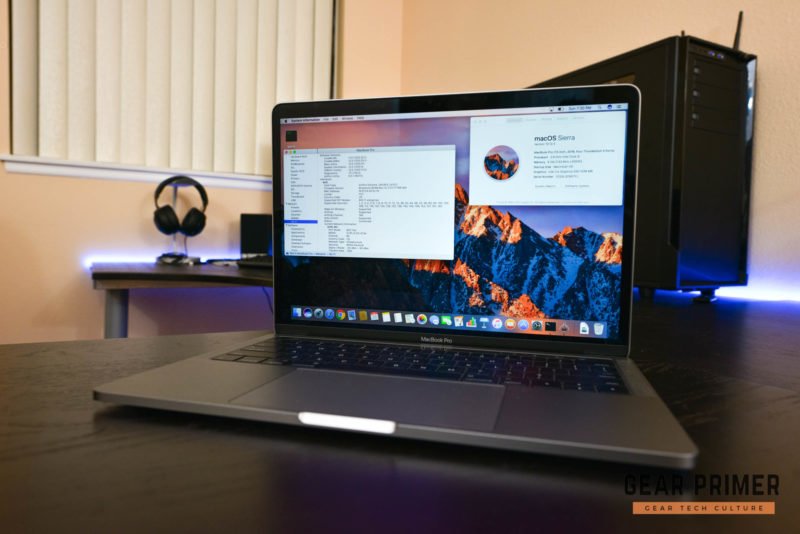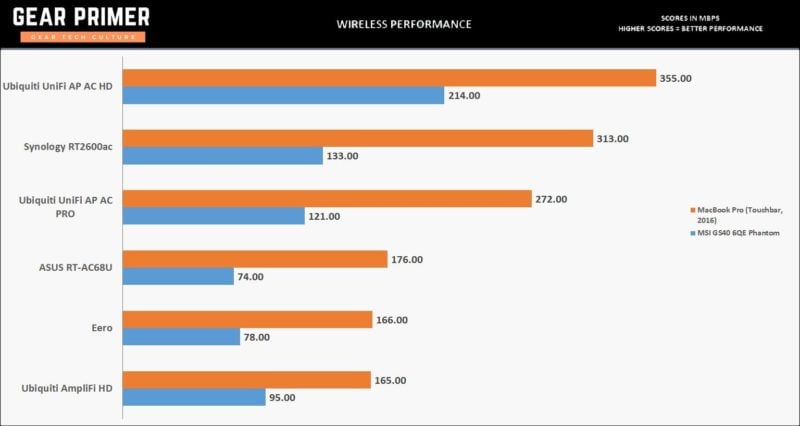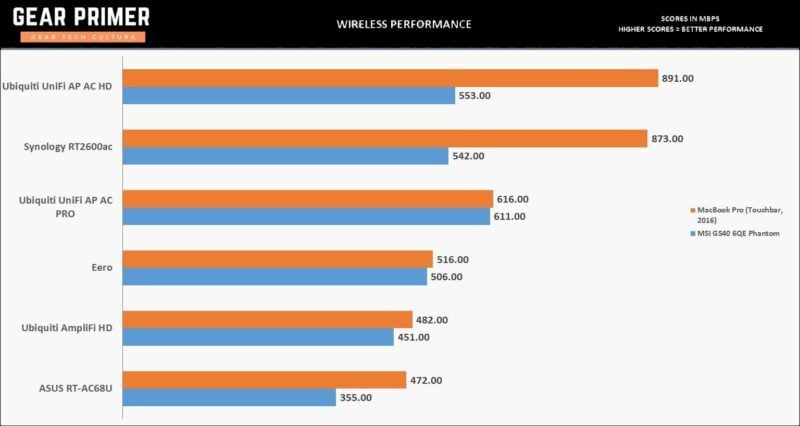
The Quest for Wi-Fi Perfection
The new Apple MacBook Pro (Touchbar, 2016) is quite the mixed bag. On one hand the thinner and lighter design, the beautiful Retina display, and the cool new TouchBar makes it one of the best MacBook Pros ever, but on the other hand, lackluster hardware, USB-C exclusivity, and the extremely high pricetag makes it a lot less appealing than its predecessor.
While internal components such as the CPU, graphics, battery size, etc. may be a bit uninspired, one component that Apple hasn’t skimped on for this generation is the internal Wi-Fi. Rather than stick with the usual 802.11AC with a 2×2 MIMO antenna setup typically seen on most laptops, Apple has decided to opt for a 802.11AC with a 3×3 MIMO antenna setup which makes it one of the very few laptops on the market with a 3×3 MIMO antenna system.
Does a 3×3 MIMO Wi-Fi system actually make a difference or is it just marketing hype? Let’s find out!
Performance
Wireless Performance
Wireless performance is tested by connecting two systems, one server (Realtek 8111GR) and one client to either a router or access point. Transfer speeds between the two systems is then tested using iPerf 3.1.3. Wireless interference is minimized as much as possible however, a few neighboring Wi-Fi signals are present from other residences around the area.
For today’s testing, we’ll be comparing two clients, the MSI GS40 6QE Phantom packing the Killer 1525 Wi-Fi chipset and the Apple MacBook Pro (Touchbar, Late 2016) packing the Airport Extreme Broadcom 43xx based Wi-Fi chipset.
| MSI GS40 6QE Phantom | Apple MacBook Pro (Touchbar, Late 2016) | |
|---|---|---|
| Wi-Fi Chipset | Killer 1525 | Airport Extreme (BCM43xx) |
| Antenna Configuration | 2×2 MIMO | 3×3 MIMO |
| Purchase Link | Click Here | Click Here |
In order to compare Wi-Fi perforamance between the two laptops, we’ll be using several different routers and access points which features 2×2 MIMO, 3×3 MIMO, and 4×4 MU-MIMO setups.
| Wireless Chipset | Antenna Configuration | Purchase Link | |
|---|---|---|---|
| Eero | QCA9882 | 2×2 MIMO | Click Here |
| ASUS RT-68U | BCM4360 | 3×3 MIMO | Click Here |
| Ubiquiti AmpliFi HD | QCA9880 | 3×3 MIMO | Click Here |
| Ubiquiti UniFi AP AC PRO | QCA9890 | 3×3 MIMO | Click Here |
| Synology RT2600ac | QCA9984 | 4×4 MU-MIMO | Click Here |
| Ubiquiti UniFi AP AC HD | QCA9994 | 4×4 MU-MIMO | Click Here |
Testing will be conducted in two locations within a two story, 1,500 square ft rectangular shaped house. Unless unavailable, the 5GHz band will be used.
Location 1
Location 1 is in the same room as the router/access point with direct line of sight. Total distance between the router/access point and client is approximately 5 feet. Results of performance testing is in the 5GHz band which provides maximum performance.

Location 2
Location 2 is in the far end of the house with the router/access point placed in one corner of the second floor and the client placed in one corner of the first floor. Total distance between the router/access point and client is approximately 40 feet with walls in-between. Results of performance testing are in the 5GHz band which provides maximum performance.

Performance Analysis
Looking at our results here, the MacBook Pro’s Wi-Fi chipset is clearly superior compared to the Killer 1525 Wi-Fi chipset used in the MSI GS40 6QE Phantom.
When testing at Location 1 with direct line of sight using the Ubiquiti UniFi AP AC HD access point and the Synology RT2600ac router, the MacBook Pro was able to reach nearly 900Mb/s, which is only marginally short of Gigabit transfer speeds. However, with a router/access point without a 4×4 MU-MIMO setup, performance is fairly similar to the Killer 1525 Wi-Fi chipset’s performance.
At longer distances, the MacBook Pro’s Wi-Fi is once again clearly faster than what’s capable from the MSI GS40 6QE Phantom. This is likely due to both the superior Wi-Fi chipset onboard the MacBook Pro as well as the better antenna/better placed antenna setup.
Conclusions
Looking at some of the results here, I was pleasantly surprised by the MacBook Pro. Considering a 3×3 MIMO antenna setup on 802.11ac has a maximum theoretical speed of up to 1.3Gbps, being able to reach a near 900Mbps is very impressive, even if this is only for a line of sight connection.
So to answer the question of is 3×3 MIMO a marketing gimmick? No, no it is not. However, reaching performance close to theoretical will require owning a router or access point capable of the level of performance.

Hey, great article but I think you mixed up the charts of Location 1 and Location 2. Besides that, very informative!